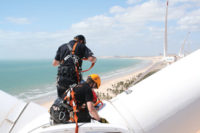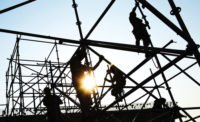New ANSI Z359 Fall Protection Code standards

Q: What do these new standards mean to me and what do I need to do to be ready for them?
A: In brief, the ANSI Z359.6 was developed for engineers designing active fall protection systems such as travel restraint systems and vertical and horizontal lifeline systems. The ANSI Z359.12-2009 standard covers manufacturing requirements for design, performance, testing and markings of snaphooks, carabiners and other fall protection connectors. The ANSI Z359.13-2009 standard might be the most significant and might directly affect most employers and users of personal fall protection. The ANSI Z359.13 has established new requirements for the design and performance of energy-absorbing (EA) lanyards.
Q: What is the significance of the new ANSI Z359.13-2009 energy absorber standard?
A: The ANSI Z359.13-2009 standard has developed new design criteria for the performance and testing methods of EA lanyards. Specifically, the new ANSI energy absorbers will increase the user’s deceleration distance from 42 inches (3.5 ft) to 48 inches (4.0 ft), which will increase your overall potential fall distance. Also, Y-Lanyards, sometimes referred to as twin-leg or 100 percent tie-off lanyards, may be required to have a warning label directing users how to safely store the unused leg on many manufactures’ EA lanyards.
Q: How can ANSI deviate from the OSHA standard stating that a shock absorber must be 42 inches and not exceed 900 lbs. of force on the worker, and will I be in violation with OSHA?
A: No, you will not be in violation with OSHA by following the new ANSI Z359.13 standard. OSHA has a policy of issuing “de minimis” notices to employers who comply with more current versions of consensus standards, to the extent that the more current versions are at least as protective as the older versions. The OSHA “de minimis” notices allow consensus standards, such as ANSI, to develop standards with new technologies that advance safety in the workplace. (http://www.dol.gov/federalregister/ Search/GetHtml.aspx?DocID=10157)
Q: Why did ANSI increase the deceleration distance from 42 to 48 inches?
A: Through extensive testing, advances in engineering and improvements in testing equipment the ANSI Fall Protection Code committee has discovered that the past energy absorber requirements are not as effective as once thought. Through re-engineering the EA materials and subjecting these materials to a battery of dynamic tests, a new standard was developed. This new standard will decrease the deceleration forces, to approximately 900 lbs. in a six- foot free fall and fall arrest, particularly in the upper reaches of the weight range where the previous standard fell short.
Q: Why is a warning label required on some EA Y-Lanyards (100 percent tie-off)?
A: If the unused leg of some EA Y-Lanyards is parked on a hip D-ring during a fall arrest, forces of the fall may be transferred to the hip D-ring. This might cause injury to the user. There is a simple solution to avoiding this issue in most cases. If you have a lanyard park or clip, located at or near your chest strap on your harness, you can attach the unused leg to the lanyard park. This will shorten the distance between your unused snaphook and the fall arrest D-ring, which will prevent potential injury from the unused lanyard leg.
Q: Do I have to throw out my old EA lanyards and replace them with new EA lanyards after November 16, 2009?
A: The ANSI Z359.13-2009 standard is a voluntary standard, so you are not required by law or OSHA regulation to replace your existing equipment. However, many companies might want to take a proactive approach and update their fall protection immediately to the standard of greatest consequence. At the very least you will want to replace your equipment, as it is removed from service, with the EA lanyards meeting the ANSI Z359.13-2009 standard.
Q: Will I be safe using the old standard EA lanyard?
A: If you have inspected and use your EA lanyard as recommended by the manufacturer, you should be fine. However, if the total worker mass or capacity rating (body plus tools and equipment total weight) is above 250 lbs. and not exceeding 310 lbs., you might want to consider replacing his present EA lanyard. In effect, the standard change has reduced the deceleration forces to approximately 900 lbs. on the body, in a six-foot free fall, only in the higher reaches of the capacity rating. For all others (130-249 lbs.) the deceleration forces remain the same, at or below 900 lbs., as the previous standard, in a six-foot free fall. The new ANSI Z359.13-2009 standard covers the same capacity rating as it has in the past — 130 to 310 lbs. (59-140 kg).
Q: I just bought a new EA lanyard with 3,600-lb. gate snaphooks. Will I have to go out and replace my new lanyard by November 16th even though it is in good condition?
A: No, you will not have to replace your present EA lanyard if it has been inspected to be in good condition. In fact, fall protection manufacturers and distributors will have existing EA lanyard inventories to sell beyond the new standard date. As manufacturers and distributors cycle through their inventory, new standard product will become available. Though the ANSI Z359 Fall Protection Code is a voluntary standard, manufacturers are ethically required to assemble EA lanyards to the new standard beginning November 16th and will no longer produce to the old standard. When you are ready to buy a replacement EA lanyard, you will want to buy an EA lanyard marked ANSI Z359.1-2007 or the ANSI Z359.13-2009.
Q: Does the new ANSI Z359.13-2009 EA lanyard require 3,600-lb. gate strength snaphooks?
A: Yes, all ANSI Z359 lanyards, manufactured since November 24, 2007, are required to have the minimum 3,600-lb. gate strength snaphooks.
Q: Is deceleration distance the same in the 12-foot free fall EA lanyard as the six-foot free fall EA lanyard?
A: No, they are different. The 12-foot free fall personal energy absorber has a maximum deceleration distance of 60 inches (5 ft.). Once again it is imperative the user calculate the total potential fall distance or clearance needed when using the 12-foot free fall personal EA lanyard is used.
Q: How much clearance would be needed for the 12-foot free fall personal energy-absorbing lanyard?
A: The 12-foot free fall (FF) personal energy-absorbing lanyard will require the user to calculate a clearance from the anchor point to the obstructions, equipment, and/or the ground below of approximately 20 feet. This calculation includes a 3-foot safety factor. When comparing the identical work space of a potential fall arrest for a 6-foot FF vs. 12-foot FF, the 12-foot FF would require approximately 7’ additional clearance below the worker (additional 6-foot FF plus 1-foot energy absorber deployment). Consult your Competent Person or safety professional when calculating your potential fall distance and circumstances specific to your worksite.
Q: I have a worker who exceeds the ANSI capacity of 310 lbs. What EA lanyard can I use for him?
A: At this time ANSI considers anyone over 310 lbs. to be outside the scope of this standard. The thought process behind the ANSI committee’s decision to exclude heavy workers (over 310 lbs.) was the unknown physical effects of a fall, suspension, and rescue time of the heavy workers following a fall. The capacity or strength of fall protection equipment was never an issue. There is not enough research in the area of fall arrest and suspension trauma, as well as rescue time, with the heavy worker at the present time.
Q: Does the ANSI Z359 Standard Fall Protection Code apply to the construction industry?
A: No, the ANSI Z359 Standard affects general industry only. However, you may want to use fall protection products manufactured to this standard due to the increased security of the 3,600-lb. gate strength and personal energy absorber changes that may positively affect your company’s fall protection program.
Resource
Click on the ASSE Resource Center at www.ishn.com, click on “Standards,” and click on the description of ANSI/ASSE Z359.2- 2007 Minimum Requirements for a Comprehensive Managed Fall Protection Program.Looking for a reprint of this article?
From high-res PDFs to custom plaques, order your copy today!








